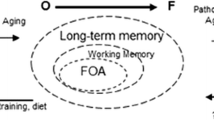Abstract
In this study, we assess the impact of normal aging on top-down modulation, a cognitive control mechanism that supports both attention and memory by the suppression and enhancement of sensory processing in accordance with task goals. Using fMRI (functional magnetic resonance imaging), we show that healthy older adults demonstrated a prominent deficit in the suppression of cortical activity associated with task-irrelevant representations, whereas enhancement of task-relevant activity was preserved. Moreover, this suppression-specific attention deficit correlated with impaired working memory performance.



Similar content being viewed by others
References
Craik, F.I. & Salthouse, T.A. Handbook of Aging and Cognition II (Erlbaum, Mahwah, New Jersey, 2000).
Awh, E. & Jonides, J. Trends Cogn. Sci. 5, 119–126 (2001).
de Fockert, J.W., Rees, G., Frith, C.D. & Lavie, N. Science 291, 1803–1806 (2001).
Rainer, G., Asaad, W.F. & Miller, E.K. Nature 393, 577–579 (1998).
Ploner, C.J. et al. Eur. J. Neurosci. 13, 357–363 (2001).
Gazzaley, A., Cooney, J.W., McEvoy, K., Knight, R.T. & D'Esposito, M. J. Cogn. Neurosci. 17, 507–517 (2005).
Hasher, L. & Zacks, R.T. The Psychology of Learning and Motivation Vol. 22 (ed. Bower, G.H.) 193–225 (Academic, New York, 1988).
Chao, L.L. & Knight, R.T. Cereb. Cortex 7, 63–69 (1997).
West, R. Mem. Cognit. 27, 1064–1072 (1999).
Epstein, R., Harris, A., Stanley, D. & Kanwisher, N. Neuron 23, 115–125 (1999).
D'Esposito, M., Deouell, L.Y. & Gazzaley, A. Nat. Rev. Neurosci. 4, 863–872 (2003).
May, C.P., Hasher, L. & Kane, M.J. Mem. Cognit. 27, 759–767 (1999).
McDowd, J.M. J. Gerontol. B Psychol. Sci. Soc. Sci. 52, P265–P273 (1997).
Alain, C. & Woods, D.L. Psychol. Aging 14, 507–519 (1999).
Milham, M.P. et al. Brain Cogn. 49, 277–296 (2002).
Acknowledgements
This work was supported by the US National Institutes of Health and the American Federation of Aging Research (A.G.) and the NIH (M.D.). We thank D. Pino for helpful discussions and J. Hoffman and A. Rutman for assistance with neuropsychological testing.
Author information
Authors and Affiliations
Corresponding author
Ethics declarations
Competing interests
The authors declare no competing financial interests.
Supplementary information
Rights and permissions
About this article
Cite this article
Gazzaley, A., Cooney, J., Rissman, J. et al. Top-down suppression deficit underlies working memory impairment in normal aging. Nat Neurosci 8, 1298–1300 (2005). https://doi.org/10.1038/nn1543
Received:
Accepted:
Published:
Issue Date:
DOI: https://doi.org/10.1038/nn1543
- Springer Nature America, Inc.
This article is cited by
-
Effects of chronic physical exercise on executive functions and episodic memory in clinical and healthy older adult populations: a systematic review and meta-analysis protocol
Systematic Reviews (2024)
-
Stimulus specific cortical activity associated with ignoring distraction during working memory encoding and maintenance
Scientific Reports (2023)
-
The mechanisms of far transfer from cognitive training: specifying the role of distraction suppression
Psychological Research (2023)
-
Effects of acute alcohol administration on working memory: a systematic review and meta-analysis
Psychopharmacology (2022)
-
Reduced frontal white matter microstructure in healthy older adults with low tactile recognition performance
Scientific Reports (2021)





